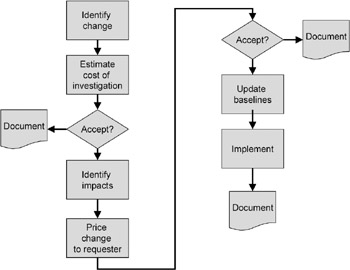What is scope change control?
|
Any project that has ever been done has probably had scope changes. It is only reasonable that as a project develops, learning takes place and the environment of the project changes. These changes can result in scope changes on the project. Since they are nearly inevitable, it is best to prepare to deal with changes rather than be surprised when they occur and try to resist them.
One of the things you will need in order to control the changes is a clear definition of the project deliverables. Unless the deliverables are clear when the scope baseline of the project is established, it is difficult to know when a change is requested whether it is or is not part of the already established project scope. Many conflicts can be avoided by having a clear scope baseline that all of the stakeholders have agreed to.
Since changes to the project scope are inevitable, we should have a means of changing the scope in such a way that the changes can be managed successfully into the project without causing havoc. This is what we mean by scope change control.
Tell me more …
Any project that has ever been completed has probably had changes to its scope. Many times you hear managers say, "Changes are killing us!" What the manager really means is that our inability to control changes is what is killing us. In reality, properly controlled and managed changes can be a great benefit to the company. The reason for this is that we are paid for changes if they are managed correctly.
Changes are the result of many things. They can be caused by an external event such as the change of a government regulation, a change in technology, a change in the marketplace, an error or omission in the original scope of the project, and an addition to the value to the project.
The basis for a good change management system starts with the establishment of the scope baseline. The time at which the scope baseline is established depends on the amount of tracking that is desired for changes. Once the scope baseline is established, it is necessary to process an approved change to change the baseline. The scope baseline can be established early in the project. This will provide a tracking system for changes to the project scope from the beginning. The trouble is that establishing the scope baseline too early in the project will make it necessary to generate a lot of change orders before the project requirements are finalized. The advantage is that there will be a record of the changes requested, accepted, and rejected starting early in the project. The cost and benefits of deciding when to establish the baseline must be considered.
A good scope change control system is one that makes sure that all of the stakeholders concerned with the change are made aware that it is being submitted, agreed upon, processed, disapproved or approved, and implemented. Change management must be careful to ensure that budgets, schedules, performance, and documentation are all changed to reflect the change.
Changes should be managed through a change management procedure, as shown in Figure 2-13. The procedure should require that some formal document be filled out collecting the important information, such as a full description of the requested change and places for the originator and contact information. Space should be provided to gather the information on researching and processing the change.

Figure 2-13: CHANGE MANAGEMENT PROCESS
One of the most important things that the change control procedure will do for the project team is to determine who pays for the change. Any good change procedure should require an evaluation and investigation phase. This will ensure that the change is carefully thought out and that all of the stakeholders affected have an opportunity to confer on it.
It is important that the investigation of the change be paid for by the stakeholder who originated the change. This is important for two reasons. The project budget and resources can be quickly used up investigating changes suggested by various stakeholders. This is especially true if there is no cost to the stakeholder requesting the change. The requesting stakeholder will be more reluctant to request changes if he must first obtain approval for the request and obtain funds for the investigation.
|
EAN: 2147483647
Pages: 126